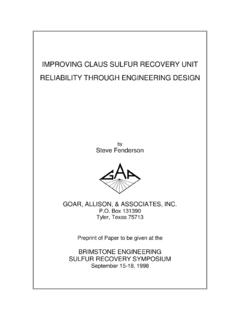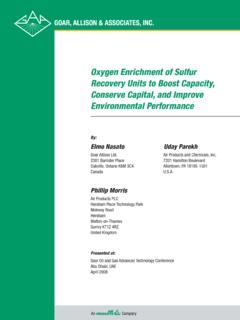Transcription of CONTINUED DEVELOPMENT OF THE - Goar, Allison
1 CONTINUED DEVELOPMENT of the D GAASS sulfur degasification ProcessBy:Steve Fenderson, , Allison & Associates, Sybil LaneTyler, Texas 75703 Presented at:Brimstone Engineering sulfur Recovery SymposiumCanmore, Alberta April 30 May 4, 2001 ABSTRACT Claus unit product sulfur normally contains 250-350 ppmw H2S in the form of dissolved H2S and chemically bound polysulfides, H2SX. The H2S is slowly released from stored sulfur product as the product is cooled and/or agitated and over time. Storage and handling operations can emit noxious odors and release toxic and explosive mixtures of H2S in air. Historically, sulfur has not been degassed to remove H2S.
2 There are a few countries that have implemented limits on the residual H2S concentration allowed in liquid sulfur shipments, and some companies are implementing sulfur degassing to control odor and improve safety and/or meet customer product specifications. The Goar, Allison & Associates, Inc. D GAASS Process was developed to provide an inexpensive, small footprint process for sulfur degassing. The D GAASS Process has been in service at the Sulconam Plant in Montreal since September 1996. It is particularly well suited for retrofitting to existing plants. The process has received wide acceptance by the sulfur recovery industry over the past two years.
3 Since the Sulconam Unit start-up, Goar Allison has collected extensive data to confirm and update our design methods. Degassing process performance factors are discussed, and test results from the latest testing are presented in this paper. There have also been improvements in the D GAASS Process to increase the unit reliability and reduce the total sulfur emissions from the sulfur recovery area. INTRODUCTION All product sulfur from modified Claus process sulfur recovery units (SRU s) contains residual H2S; some as dissolved H2S and some in the form of loosely chemically bound polysulfides, H2Sx.
4 The total residual H2S concentration is influenced by the H2S vapor concentration (partial pressure) and the temperature at which the sulfur product condensed. As SRU s are pushed to and beyond their design capacities, the H2S content of product sulfur Oxygen enrichment also results in higher residual product The average H2S concentration in typical SRU product sulfur is 250-350 ppmw. Some H2S is released during sulfur storage, handling, and transportation. The released H2S results in safety hazards from the toxic H2S gas and potentially explosive concentrations of H2S and Solid sulfur product formed from undegassed liquid sulfur is more friable (prone to fracture and create dust).
5 The release of H2S from solid or liquid product results in noxious odors. Undegassed sulfur is also more corrosive. degasification of liquid sulfur controls most of the above listed problems. Several factors contribute to the release of H2S from liquid product sulfur (degassing). The primary factors that contribute to this release during normal operation are low H2S concentration in the gas above the liquid sulfur , mechanical agitation, cooling, and time. The equilibrium ratio of H2S and H2Sx is dependent on temperature; the ratio of H2S/H2Sx is about at 155 C (311 F) and 10 at 125 C (257 F).
6 1,4,5 Over time, dissolved H2S will desorb into the gas phase; physical desorption is favored by low H2S - 1 - gas concentrations. As H2S is desorbed, some H2Sx is converted to H2S to maintain the equilibrium H2S/H2Sx ratio. The conversion of H2Sx to H2S is relatively slow, and the overall degassing rate is primarily controlled by the rate H2Sx is converted to H2S. BASIS OF D GAASS PROCESS Earlier commercial degassing processes were designed to strip H2S from liquid sulfur at atmospheric pressure by passing stripping gas (normally air) through the sulfur product or passing product sulfur through a stripping gas stream.
7 These processes were designed to promote the physical desorption of H2S into the stripping air stream using a combination of mechanical agitation to increase the surface area between the sulfur and air stream and maintaining a low H2S concentration in the gas phase by continuous removal and replenishment of the stripping gas stream. The physical desorption of H2S is relatively easy and fast. However, H2Sx is a high molecular weight compound that is not volatile and therefore is not removed by physical desorption. The commercial processes required from several hours up to a few days sulfur residence time to achieve less than 10 ppmw residual H2S/H2Sx.
8 The primary reason for the long residence time was to allow conversion of H2Sx to H2S which could then be removed by physical desorption. Some processes utilize a chemical catalyst/additive to aid in the decomposition of H2Sx to H2S and reduce the required degassing time. The Shell Process sparges air into the product sulfur using specially designed pit internals. Two of the earlier processes based on passing sulfur through an air stream are the Texas Gulf Sulphur and SNEA Processes. The SNEA process also uses a catalyst. The original Exxon Process was based on chemical catalyst addition and very long residence time to allow the H2S to weather off.
9 A more recent Exxon DEVELOPMENT uses air sparging to reduce the required residence time. These processes are described in more detail in previously published papers. 6,7 The above described processes all use air as the stripping medium. Several other gas streams have been utilized/tested/proposed. These include gases such as SRU tail gas, CO2, and nitrogen. Steam has also been utilized in several locations. Steam sparging systems are typically homemade by the operating company. The results using these stripping alternates have not been as effective as using air. In general, air is preferred; steam is next in effectiveness, and inert gases are least effective.
10 Research by Alberta Sulphur Research Ltd. (ASRL) has identified the primary advantage of air stripping to be the direct oxidation of some of the H2S/H2Sx directly to ,8 ASRL has also determined the oxidation reaction to be primarily a liquid phase Steam stripping is thought to be more effective than inert gas stripping because small quantities of the boiler water treating chemicals are carried with the steam and catalytically promote decomposition of H2Sx to H2S. Many plants that have implemented steam stripping have experienced very significant corrosion in the sulfur pit.


